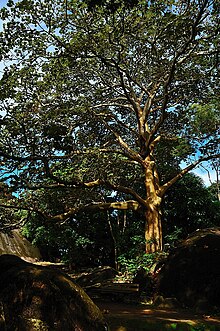Sterculia apetala
| Sterculia apetala | |
|---|---|

| |
| On the bank of the Orinoco, Venezuela | |
| Scientific classification | |
| Kingdom: | Plantae |
| Clade: | Tracheophytes |
| Clade: | Angiosperms |
| Clade: | Eudicots |
| Clade: | Rosids |
| Order: | Malvales |
| Family: | Malvaceae |
| Genus: | Sterculia |
| Species: | S. apetala
|
| Binomial name | |
| Sterculia apetala | |
| Synonyms[1] | |
| |
Sterculia apetala, commonly known as the Panama tree,[2] camoruco, manduvi tree or anacagüita,[3] is a species of flowering plants in the family Malvaceae.[1] It is found in Central and South America, as well as the Caribbean islands. Sterculia apetala is recognized as the national tree of the Republic of Panama.[4]
Description
Sterculia apetala is
Leaves are alternate, palmate with five lobes, and cluster densely at the end of branches. Including the petiole, leaf length ranges from 15-50 centimeters.[6]
Flowers are purple and yellow, and have five sepals. S. apetala flowers have no petals; structures that resemble them are in fact sepals. Flower diameter ranges between 2.5-3.5 centimeters. These flowers are unisexual, meaning there are distinct male and female individuals used for reproduction.[7]
Fruit are compounds of up to five follicles, stemming from peduncles that can reach as long as 30 centimeters. Inside the follicles are seeds, as well as orange urticating hairs that may cause pain when touched. Naturally, the tree typically flowers and bears fruit between December and March.[8]
Seeds are black ellipsoids, typically with the dimensions 2.5 x 1.5 centimeters.
Taxonomy and nomenclature
Sterculia apetala belongs to the genus Sterculia, classified under the mallow family Malvaceae. Apetala is one of 150 known species of Sterculia.[11]
The generic name Sterculia is derived from the Latin word "stercus", which translates to "excrement". This is because of the strong odor characteristic of flowers and leaves within this genus.[4]
Distribution
Sterculia apetala is found in the tropical regions of Bermuda, Mexico, Barbados, Belize, Cuba, El Salvador, Guatemala, Honduras, Jamaica, Montserrat, Panama, Puerto Rico, Saint Kitts and Nevis, Trinidad and Tobago, Bolivia, Brazil, Colombia, Ecuador, Peru, and Venezuela.[12]
Uses
Wood from Sterculia apetala is used to produce cases, crates, industrial and domestic woodware, canoes, and tool handles. The tree is often grown for shade, resulting from its large leaves.[4][12] In some regions, seeds are consumed after being boiled or roasted, used to flavor chocolate, or given to animals as fodder.[9] The flowers are used as antitussive.[13]
Conservation
In the Pantanal wetlands of Central Brazil, the endangered hyacinth macaw (Anodorhynchus hyacinthinus) makes its nest almost exclusively in the natural hollows of S. apetala.[14]
Gallery
-
Sterculia apetala tree and leaves
-
S. apetala fruit
-
S. apetala follicle and seeds
-
S. apetala fruit and flowers
-
S. apetala flower cluster
-
S. apetala individual flowers
-
S. apetala old trees
-
S. apetala trunk and bark
References
- ^ a b c "Sterculia apetala (Jacq.) H.Karst". The Plant List. 2013. Retrieved 28 March 2015.
- ^ a b USDA, NRCS (n.d.). "Sterculia apetala". The PLANTS Database (plants.usda.gov). Greensboro, North Carolina: National Plant Data Team. Retrieved 3 December 2015.
- ISBN 978-959-05-0713-7.
- ^ Gobierno de México.
- ISSN 0044-5967.
- ^ "Panama watershed tree atlas". ctfs.si.edu. Retrieved 2018-04-12.
- OCLC 705945360.
- ^ STRI. "Smithsonian Tropical Research Institute-Sterculia apetala". biogeodb.stri.si.edu. Retrieved 2018-04-16.
- ^ PMID 28777691.
- PMID 30021965.
- ^ "Malvaceae | plant family". Encyclopedia Britannica. Retrieved 2018-04-14.
- ^ a b "Sterculia apetala (Panama tree)". www.cabi.org. Retrieved 2018-04-15.
- ISBN 978-959-05-0663-5.
- .
External links
 Media related to Sterculia apetala at Wikimedia Commons
Media related to Sterculia apetala at Wikimedia Commons Data related to Sterculia apetala at Wikispecies
Data related to Sterculia apetala at Wikispecies








